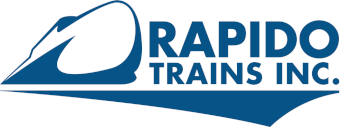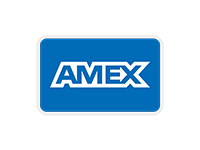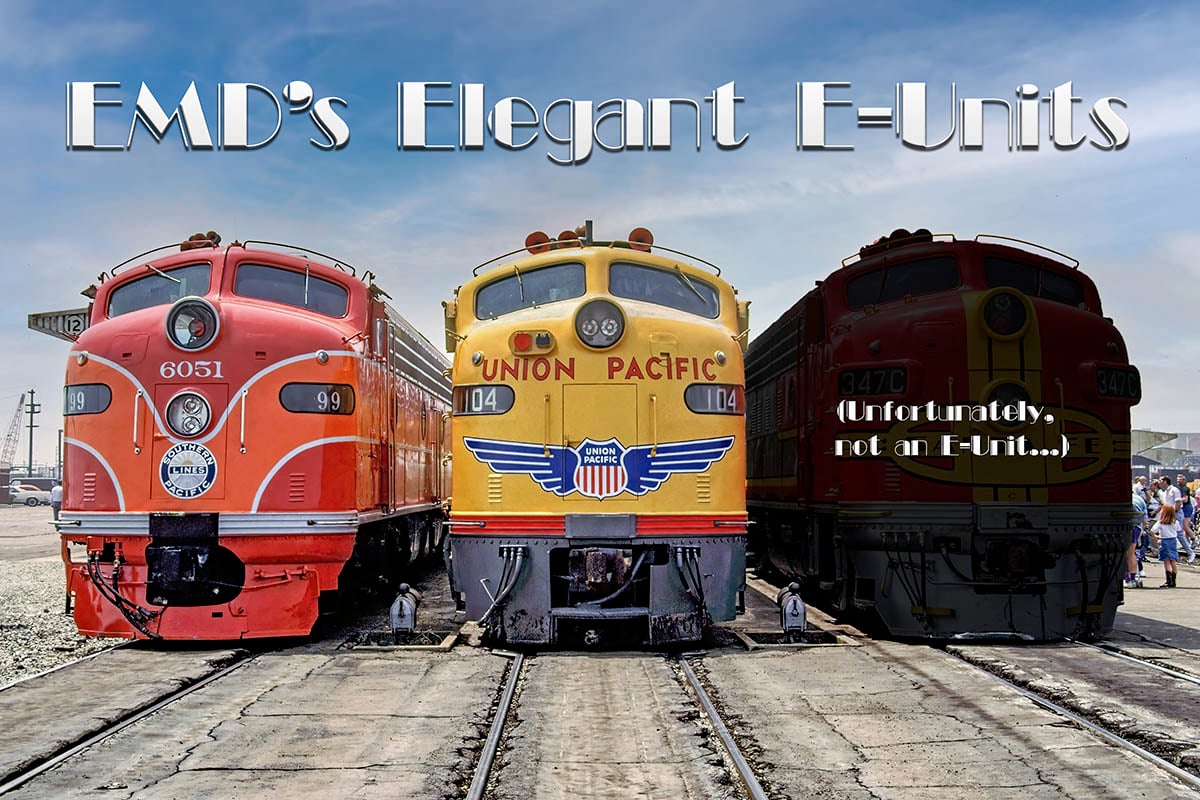
As part of the celebration of Los Angeles Union Passenger Terminal's 50th Anniversary, cab units from the three original tenant railroads were posed next to each other for the many photographers present. From left to right are Southern Pacific E9A 6051, Union Pacific E9A 951 and Santa Fe F7A 347C on May 6, 1989. The SP and ATSF diesels are owned by the California State Railroad Museum, and the UP's E-unit is part of that road's historic fleet. The SP engine is carrying the number for the Coast Daylight in its numberboards, while the UP unit has the City of Los Angeles' number in its boards. (Santa Fe didn’t display train numbers on their locomotives.) Craig Walker photograph
Development of General Motors’ Foray into Passenger Diesel Production
"The diesel that did it" is often used to describe General Motors’ Electro-Motive FT freight diesel, a reference to its ability to persuade most railroads that diesel locomotive technology was superior to steam locomotives in regards to flexibility, maintenance and overall costs. While undoubtedly true, EMD’s E-units are also known similarly as the diesel that knocked steam locomotive off America’s premier passenger trains. Early diesel designs had their limits, and as a result the Burlington’s Zephyr and Union Pacific’s M-10000 were not just locomotives, but fixed-length trainsets. A single passenger steam locomotive, such as a 4-6-2 or 4-6-4, had enough power to pull a variety of train lengths, allowing the railroad’s to simply add more cars to a train when demand warranted it. The Zephyr, Flying Yankee, Green Diamond and M-10000, featured consists in which the motive power and train were inseparable. One representative of a steam locomotive builder commented after the development of these early diesel trainsets, “The truth is that this new 20th Century development of dieselized lightweight trains has not yet touched 19th Century performance with steam.”
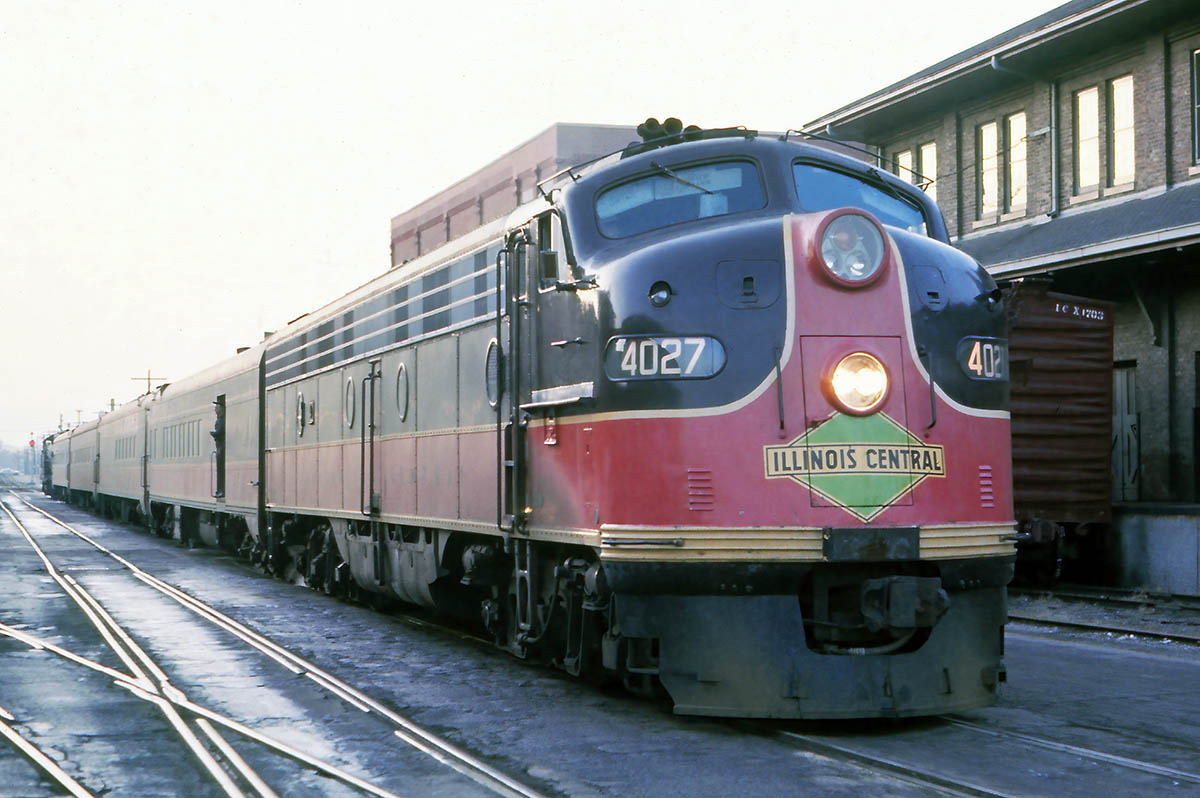
Illinois Central E8A 4027 leads the Green Diamond through Springfield, Illinois, in 1963. The mainline was east of town and the trains would head into town to the depot and a yard engine, seen on the rear of this train, would pull them back to the wye. Note the triangular Pyle-National warning light in the upper headlight housing. Craig Willett photograph
And GM’s diesel engineering staff knew this. These trainsets were limited not only by how many seats were available, but also by the fact that these early diesels lost all but 10% of their starting drawbar pull when they hit 70 or 80 miles per hour, and thus being limited to very lightweight trains of fixed length. GM’s engineers began work to design a new locomotive that would equal such existing passenger steam engines as the 4-6-4 Hudsons that were in vogue on many mainline passenger trains in the 1930s.
Eventually, they came up with a pair of 900 hp Winton 201A V-12s in a boxy 4-axle prototype, and lessons learned from that led to Baltimore & Ohio purchasing one, numbered 50, and Santa Fe purchasing a pair, numbered 1 and 1A. Lessons were, again, learned, and one was that the crews were too far forward, causing them to occasionally become transfixed by the blur of the railroad ties passing underneath them. Around this time, EMD was moving fabrication and construction to their new factory in La Grange, just southwest of Chicago. And their engineers and stylists were hard as work re-imagining both the construction and appearance of these new locomotives as well. The entire carbody was changed to a truss construction for improved strength (visible whenever the side panels are removed in the shop). Also, the carbody was redesigned to a more streamlined appearance, with the cab set back and a stylish slant-nose ahead of it. Also, the trucks were changed to 3-axle A-1-A trucks, with two powered axles per truck with a non-powered idler axle in the center, which spreads the weight of the locomotive more evenly over the track and counteracts the tendency of trucks to oscillate at high speeds, which is a problem with 2-axle trucks.
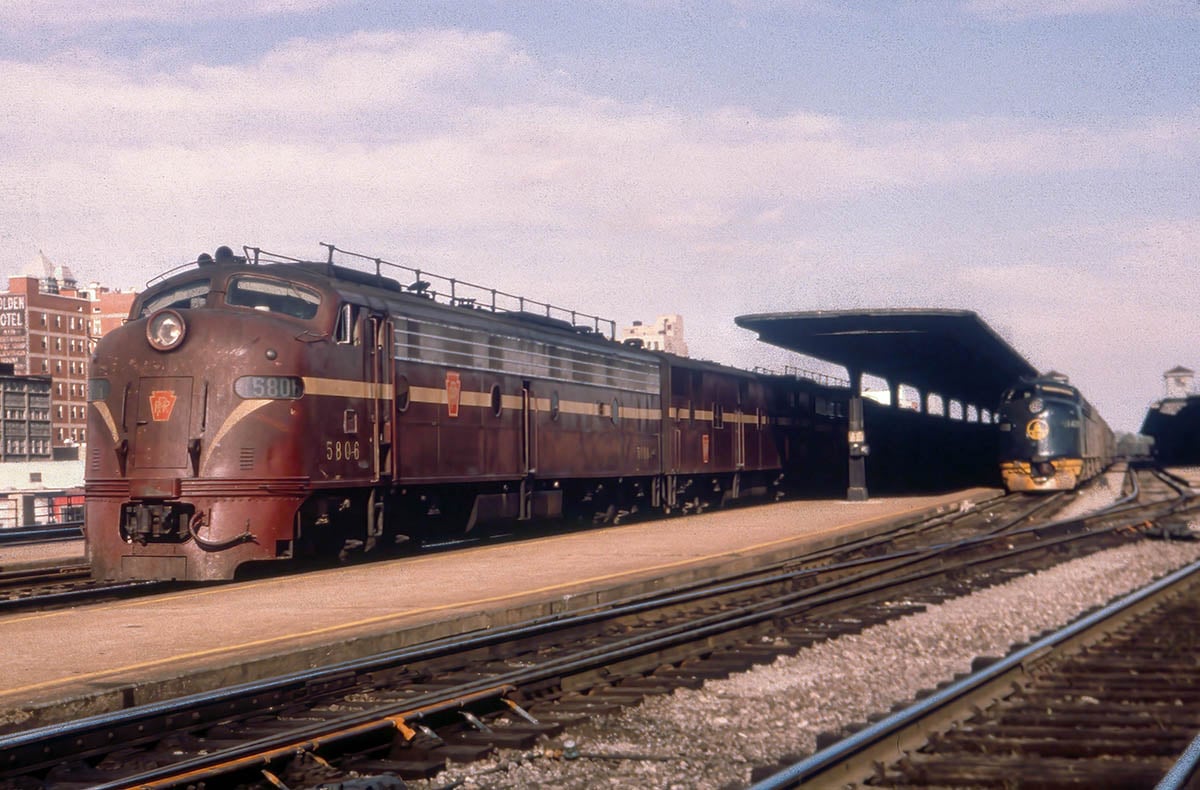
Pennsylvania Railroad E8A 5791, teamed with a pair of E7s, makes a stop in Dayton, Ohio on September 15, 1965. The Trainphone antennas that the Pennsy added to many of these E8A engines are clearly visible along the roofline. On an adjacent track is a Baltimore & Ohio train with B&O E8A up front. Louis A. Marre photograph, Gregory J. Sommers collection
These earliest E-Units had a very streamlined nose with a steeper front angle, and a variety of porthole/window styles and locations on the sides. (Want to see Rapido Trains produce early E-Unit models? Click here to request them!: https://form.jotform.com/210555532174249 ) By the time the E8s were in production, EMD had settled upon round portholes and, as on the earlier E7s, the rounded but slightly less-streamlined "bulldog" nose found on their primarily-freight F-Units. The E8 was such a classic design that the later E9s had the exact same body, other than a headlight gasket and slight variation in the side porthole rims having changed. (Of course, perhaps the design team had just gotten complacent…)
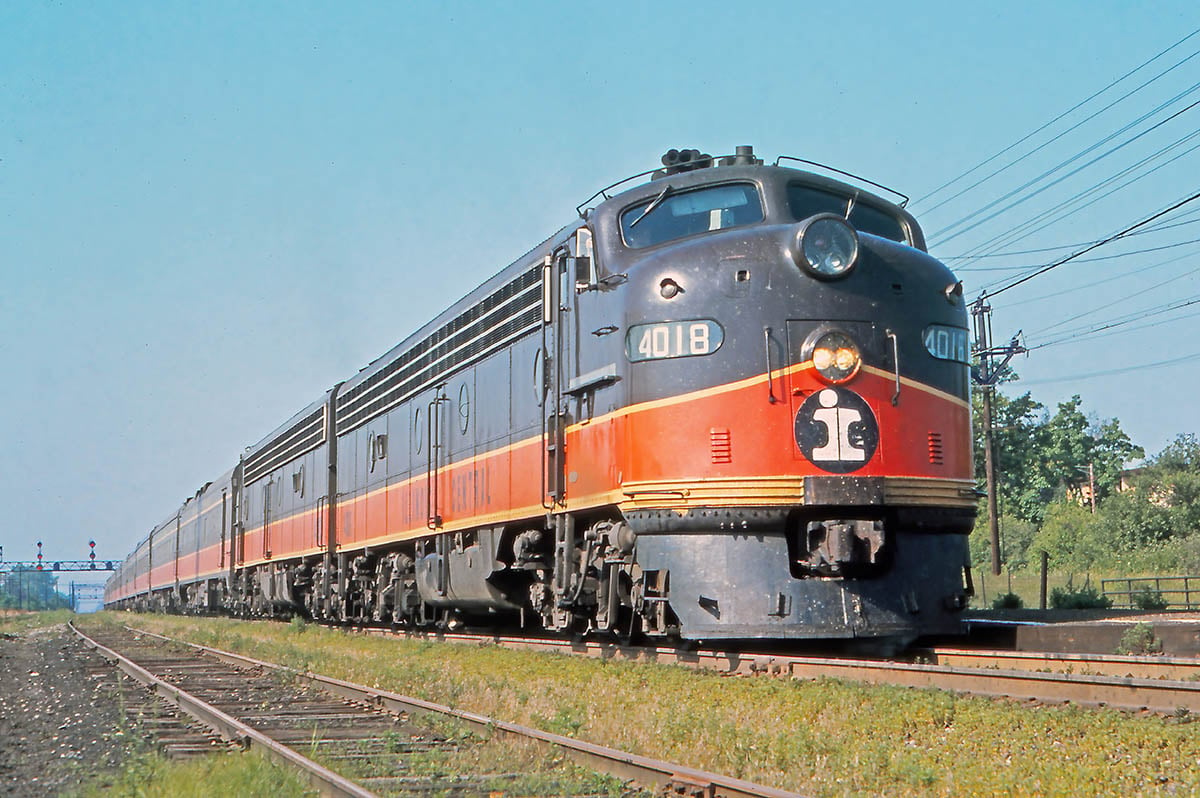
Illinois Central’s northbound Panama Limited is between Homewood, Illinois, and Chicago on the last lap of its overnight journey from New Orleans, Louisiana. Craig Willett photograph
EMD’s E-Units were so successful at replacing steam locomotives on passenger trains that they were purchased by nearly all of the United States’ railroads, with notable exceptions including Norfolk & Western (which retained steam longer than other railroads thanks to coal being their major commodity in their freight trains), Northern Pacific, Delaware & Hudson, New Haven, Rio Grande and Western Pacific. Of all the E-Units sold, only three Es were ever purchased new by any Canadian railroads, and Mexican railroads skipped them completely.
That’s Enough Backstory …Now, About EMD’s E8s and E9s
General Motors Electro-Motive Division’s E8 locomotive was first delivered in August 1949, with production continuing through December 1953. These locomotives were, as usual on cab diesels such as these ("cab diesels" being those with full-width carbodies with internal walkways along the locomotive’s length, rather than walkways exposed to the elements as on "hood diesels"), constructed as "A Units" – those with a cab, and "B Units" – booster units without a cab. (And, yes, even though B Units have no cabs, they are still considered "Cab Units"). EMD sold a lot of the earlier E7s (428 E7As and 82 E7Bs), but still managed to produce 418 E8As and 39 E8Bs.
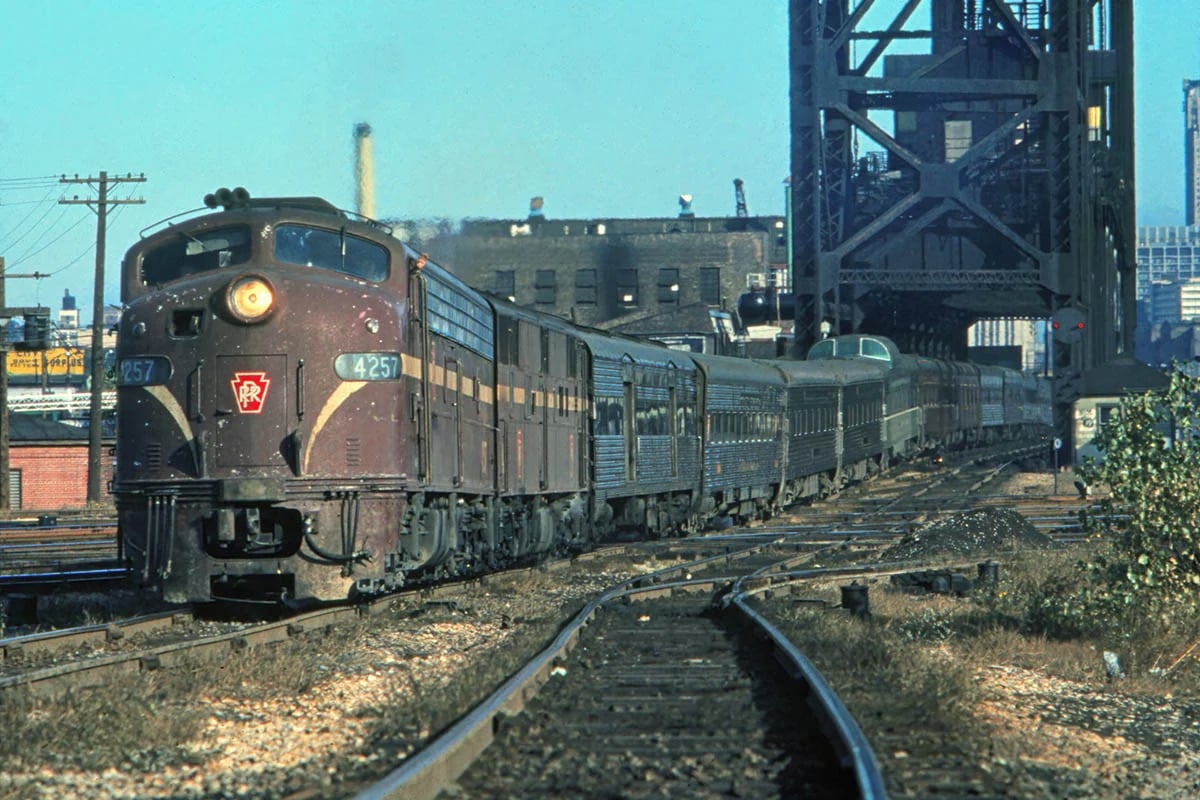
Pennsylvania Railroad’s every-other-day South Wind, with E8A 4257 and an E7A in charge of the train as it departs Chicago for Florida, crosses over the south branch of the Chicago River and through the 21st Street Interlocking just after its departure from Chicago Union Station in 1966. Note the Northern Pacific Sleeper-Dome in the consist, a regular addition in the winter season. Craig Willett photograph.
EMD made further refinements to the E-Units, resulting in the first E9s rolling out of the factory in May 1954. A total of 100 E9As and 44 E9Bs were produced before production ended in December 1963, with the final E9, Union Pacific E9A 914, having a built date of January 1964 – but, let’s face it, the bulk of that engine was built in December ’63.
EMD’s E8s and E9s were wildly successful, and many of them outlasted the railroads’ passenger train operations by becoming Amtrak property when most of America’s passenger trains were consolidated into this new passenger service on May 1, 1971. And two of the three roads that were holdouts and did not initially join Amtrak – Rock Island and Southern Railway – continued using E8As on their trains well into the 1970s. The very first locomotive to wear an Amtrak name and logo was an E8A (AMTK 4316, painted in a unique black paint scheme, was former Penn Central 4316, originally Pennsylvania Railroad 5716A). In 1971 there were still almost 600 E8 and E9 locomotives in service on American railroads and, from those, Amtrak selected 198 E8s and E9s to own (with another 13 to be leased from Union Pacific). For Amtrak’s first decade of operations, Es dominated the power on most trains, having previously toiled for B&O, BN (ex-CB&Q), C&O, L&N, MILW, PC (ex-NYC and PRR), RF&P and SCL (ex-ACL and SAL). Illinois Central leased their E8s to Amtrak, with some receiving full Amtrak paint, but unusual (for Amtrak) four-digit roadnumbers. Additionally, in 1971, Burlington Northern, Milwaukee Road, Chicago & North Western and Penn Central/New Jersey Transit still used them on commuter trains, Rock Island used them on freight, commuter and intercity passenger trains, Erie Lackawanna on freight and commuter and Canadian Pacific and Southern Railway were still using them on intercity passenger trains.
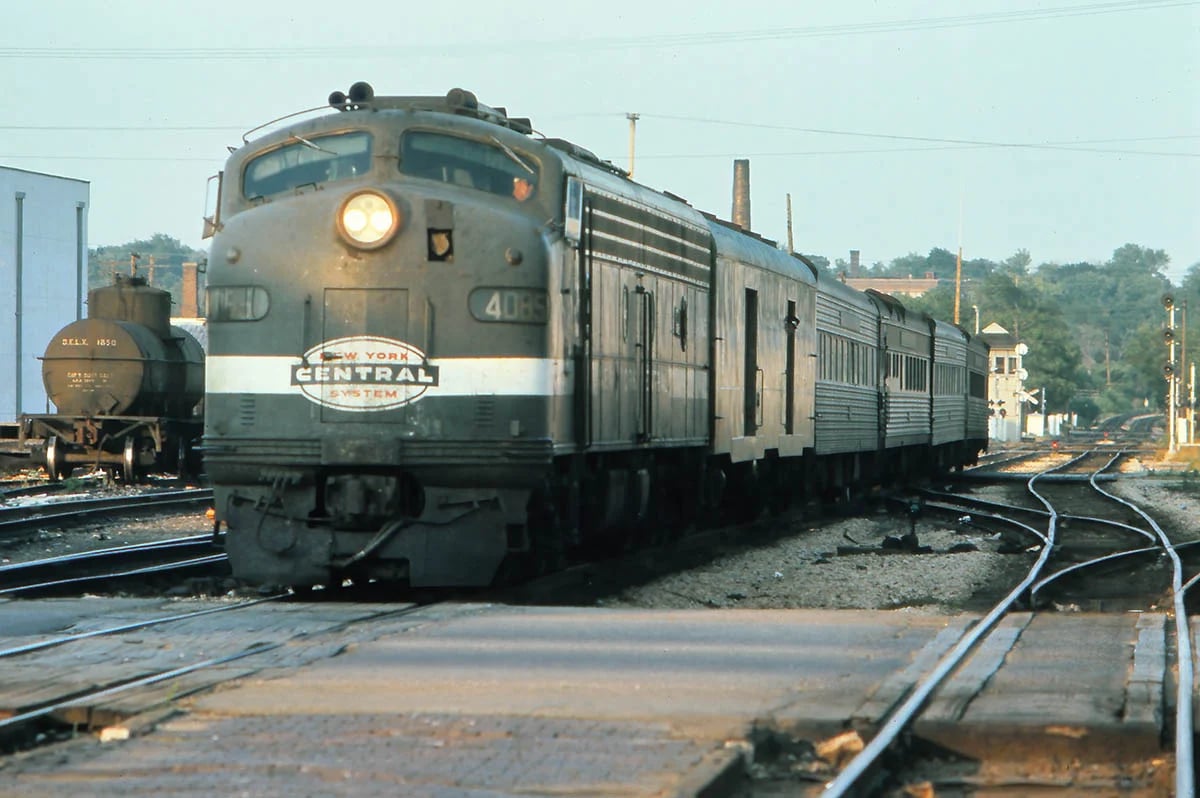
New York Central’s westbound Twilight Limited, behind E8A 4085, has just passed BO Town and is approaching the depot at Kalamazoo, Michigan, in 1966. Note that the door on the MU receptacle has been left open. Craig Willett photograph
E8 and E9 Spotting Features
The E8’s immediate predecessor was the E7, which was the first E-unit with the "bulldog" nose as opposed to the slanted nose. It also featured squared windows on the sides of the carbody, smaller screened areas above them and a large vertical louver just behind the cab. The roof has no radiator fans, but rather grilles flanking round exhaust stacks. (Want to see Rapido Trains produce an E7 models? Click here to request them!: https://form.jotform.com/210555532174249)
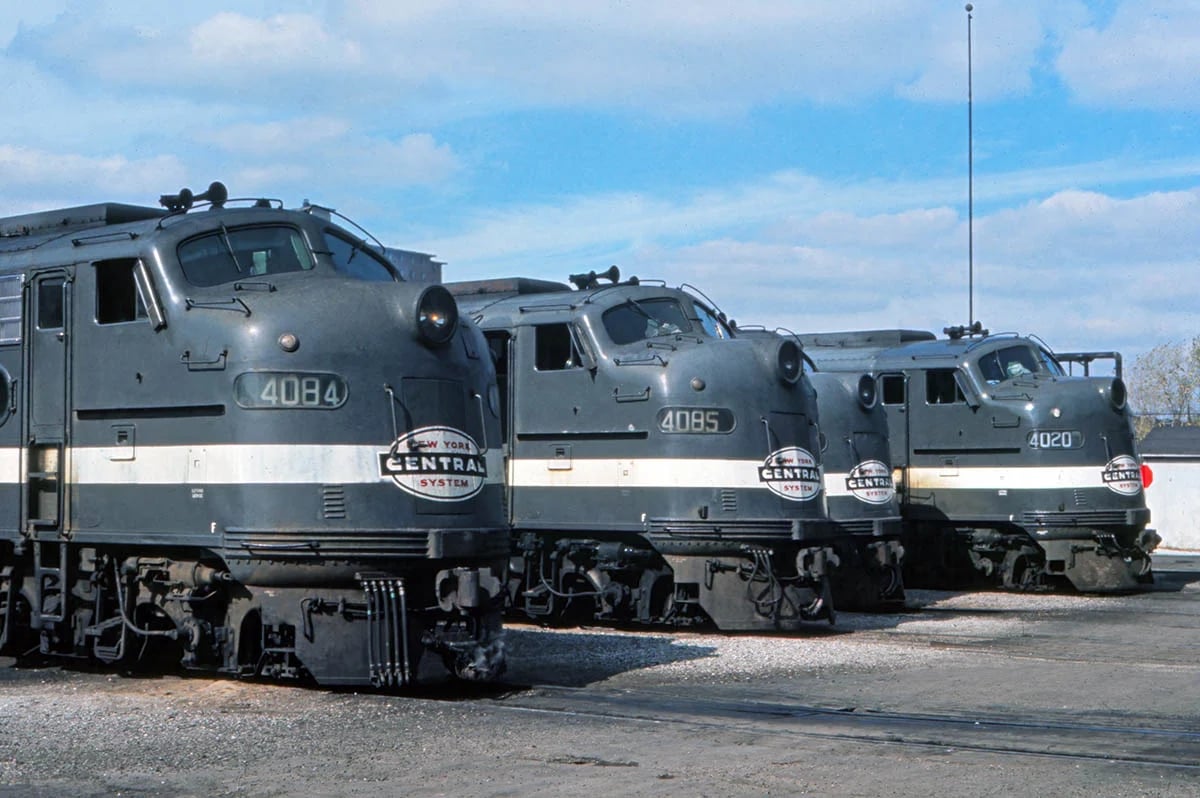
New York Central owned the largest fleet of E8As – sixty-two of them! – far more than any other railroad. Four of them are lined up on the ready track in Englewood, Illinois, awaiting their next assignments in 1966. Craig Willett photograph
The E8s, however, looked quite a bit different:- E8As and E8Bs are each 70’ 3” in length, from coupler face to coupler face. The truck centers are 43-feet apart.
- The "bulldog" nose from the E7s is essentially unchanged. Variations on the cab/nose include a single headlight, or a signal light over a headlight. Most E8As were built with flush numberboards, but protruding numberboards (as on F-Units) were found on occasion, such as on some of Rock Island’s E8As and Santa Fe’s E8Ms (which are extensively rebuilt E1A locomotives). E8Bs, of course, have no cab, and therefore no numberboards.
- The pilot options include both flush pilots that share the contours of the nose itself (often called "passenger pilots") or a pilot with a recessed crease in it near the top (often called a "freight pilots" because it was common on freight F-Units). E8Bs have no pilot.
- The sides of E8s, both As and Bs, feature four round portholes, with the two outermost portholes openable. There is a full-length grille over the carbody openings along the top of the sides – these are more often than not fabricated of stainless steel, and can be either a series of horizontal bars with vertical supports roughly 2-feet apart, or Farr grilles with a series of three rows of vertical slots.
- The rounded roof features eight 36” radiator fans, although a pair of winterization hatches cover the two forwardmost and two rearward fans, leaving only four fans clearly visible. A pair of oval exhaust stacks are visible behind the two winterization hatches. Locomotives equipped with dynamic brakes for use on mountain grades also feature a 36” fan in the center of the unit (between the foreword radiator fans and the rear radiator fans, and between the two exhaust stacks). At the rear of the roof is a hatch with steam generator vents, of which there can be early style vents, or later vents that appear a bit more streamlined. Also, some engines have one set of vents, while others (which have two steam generators) feature two sets of vents.
- Between the two A-1-A three-axle trucks are the fuel and water tanks, which appear to be one tank (it has internal dividers). As built, the tanks have a scalloped sheet metal skirt above them, creating a seamless look between the body and the fuel/water tank. Air reservoirs are located fore and aft of the fuel/water tank. Some railroads removed the skirting later in order to ease maintenance.
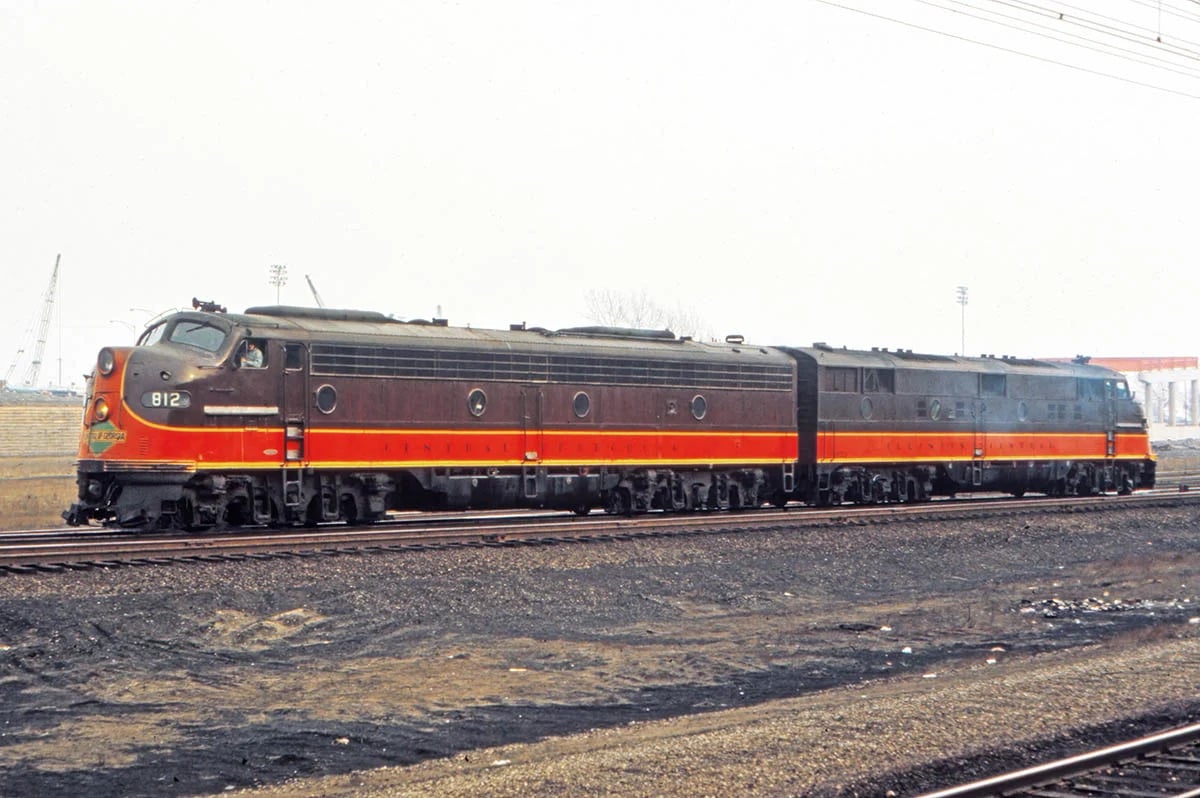
Central of Georgia repainted their two E8As into Illinois Central’s "Autumn Sunset" colors in late 1958 for through service to Chicago on the City of Miami and the Seminole. CG E8A 812 and an IC E6A 4003 are seen just south of Central Station in Chicago, Illinois, in the late 1960s. Craig Willett photograph
The E9s look a lot like E8s, but there are a few differences:- E8As and E8Bs are each 70’ 3” in length, from coupler face to coupler face. The truck centers are 43-feet apart.
- On E9As, the upper headlight has a gasket, which is more visible on the E9A than on the E8A.
- As with the E8s, both As and Bs feature four round portholes, with the two outermost portholes openable. The four unopenable portholes on E9s have a flush fit without the E8’s metal ring around the portholes, requiring a slightly larger glass disc on the two centered portholes.
In summation, EMD’s E8s and E9s are very attractive locomotives, rivaling ALCO’s PAs in aesthetics. While the PAs have a well-served reputation as perhaps the most attractive locomotives ever built, a solid case could also be made for the E-Units to be their equal or, depending upon one’s taste, even better looking thanks to a sleeker appearance. Some of us dread rankings (OK, that might just be this author being indecisive), but any passenger train looks fantastic pulled by either ACLO’s PA or EMD’s E-Units. Why quibble?
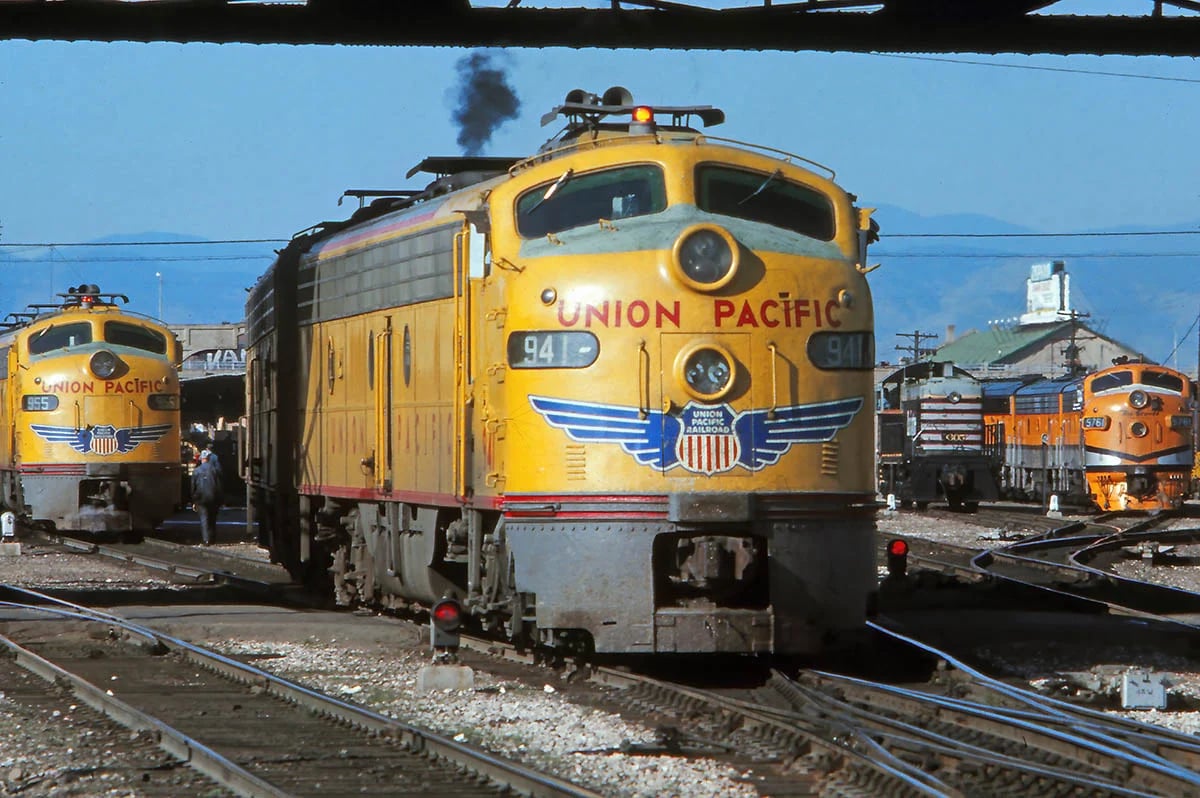
A June 1967 morning in Denver, Colorado’s, Union Station finds UP E8A 941 and E9A 955, power off the City of Kansas City and City of Portland/Denver, making their moves as a Chicago Burlington & Quincy switcher waits in the clear for the westbound California Zephyr to depart for its daily journey through the Rockies. Craig Willett photograph
Throughout their lives, many railroads modified the look of their E8s and E9s in order to either simplify maintenance, or to make changes to existing apparatus. For example:- Air horns changed depending upon each railroads’ preferences, with some utilizing a pair of single chime horns (with one facing forward and the other rearward), or their choice of 3- or 5-chime air horns from Nathan, Leslie or other manufacturers.
- Multiple Unit (MU) receptacles were added to the noses and rear ends of most E-Units as the technology for operating multiple engines in a consist evolved. MU receptacles were often placed in recesses behind hinged doors in the nose (which sometimes lost their doors in later years, leaving a recess in the nose with an MU receptacle in it) or were added to a protrusion on the nose with the receptacle mounted on that.
- Grabirons on the cab/nose or rooftops of E-Units often changed as railroads found that maintenance crews required easier access to, for example, the cab’s windshields for cleaning, with grabirons creating a ladder on either the left or right side of the nose. Some roads also included a "ladder grab" (with raised outer ends to hold a ladder in place without it sliding sideways) on one or both sides of the nose where it transitions from the side to the top. Other areas that often saw additional grabs added include the lower portion of the nose, just above the pilot’s anticlimber, above the cab sides (usually in tandem with a narrow walkway added to the side of the cab) and the rear corners of the roof (in order to provide maintenance workers when working on the steam generator vents).
- Some railroads added spark arrestors, which could consist of several variations, to the exhaust stacks of their E-units, particularly in railroads operating in dryer climates.
- Life rings, alternate headlights, blanked out portholes, removed skirting – these are all changes that occurred with some frequency by various railroads over time.
- Pennsylvania Railroad added the distinctive Trainphone antennas to the roofs of their E8As as radio technology developed. Kansas City Southern units also utilized a similar antenna, manufactured by a different supplier.
- Southern Railway (NO&NE) 6906-6915 were delivered with dynamic brakes and roof-mounted air reservoirs (four longitudinal tanks, two on each side of the fans), which allowed these engines to have supplemental water tanks where the air reservoirs typically were located, fore and aft of the fuel/water tank, in order to increase water capacity.
- Southern 2923-2929 (to 6900-05 2nd, 6916) were built without dynamic brakes and rooftop tanks, and these were later added at the road’s Spencer NC Shops. These air reservoirs were slightly shorter than those on SOU (NO&NE) 6906-6915.
- Union Pacific added fabricated metal snow shields to the roofs of their E-Units to assist with operation over the heavy snows of their crossing of the Rocky Mountains in Wyoming, as well as helping whenever there was a heavy snowfall in Utah’s Wasatch Mountains or even on the plains of Nebraska during exceptionally cold Winters.
- While EMD’s E-Units were designed and constructed for passenger service, some railroads – notably Erie Lackawanna – also used them in freight service. EL regularly assigned them to intermodal trains between the Northeast and Chicago in the 1970s (until the Conrail merger in 1976).
- As always, check photographs of prototype locomotives for detail changes made to your favorite railroad’s E-units. There is a wide variety of photos available on-line or in books and magazines. The above list is not meant to be complete.
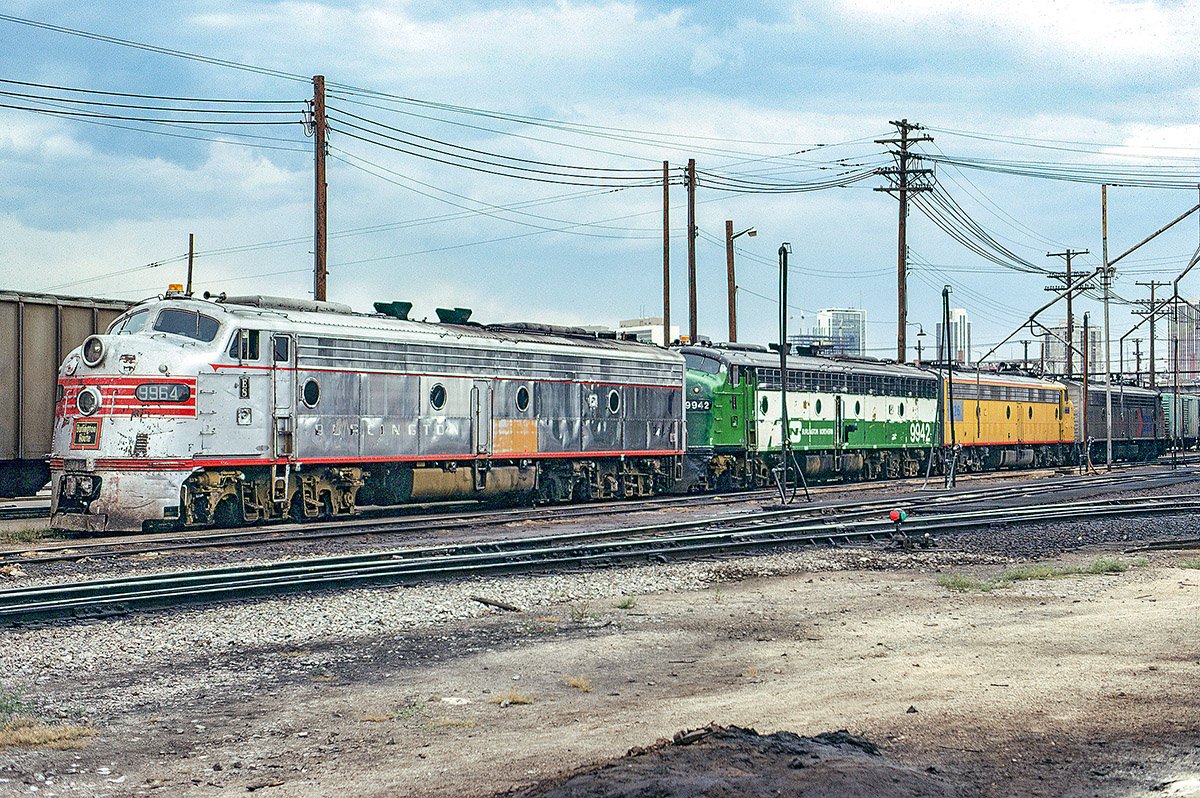
Burlington Northern E8A 9964, still wearing its Chicago Burlington & Quincy colors, at the west end of ex-CB&Q Chicago Coach Yard under the Canal Street bridge in Chicago, Illinois in 1970 or 1971. Leo J. Munson photograph
Inside E8s and E9s
We’ve discussed the external look of these E-Units, so we will now turn our attention to the insides.
While externally E8s and E9s are nearly identical in appearance, internally there are differences - which is to be expected, as otherwise why would EMD have created the E9s, which are essentially an E8 with an upgrade?
| EMD E8 | EMD E9 | |
|---|---|---|
| Diesel Engine: | (2) 1125 hp 567B | (2) 1200 hp 567C |
| Engine Type: | V-12 Two-Stroke | V-12 Two-Stroke |
| Traction Motors: | (4) GM D-27-B | (4) GM D37 |
| Total Horsepower: | 2250 hp | 2400 hp |
| Wheel Diameter: | 36” | 36” |
| Locomotive Weight – A Unit: | 315,000 lbs | 315,000 lbs |
| Locomotive Weight – B Unit: | 290,000 lbs | 290,000 lbs |
| Maximum Speed: | 85-117 mph | 117 mph |
| Production Quantities: | A-Units: 450 / B-Units: 46 | A-Units: 100 / B-Units: 44 |
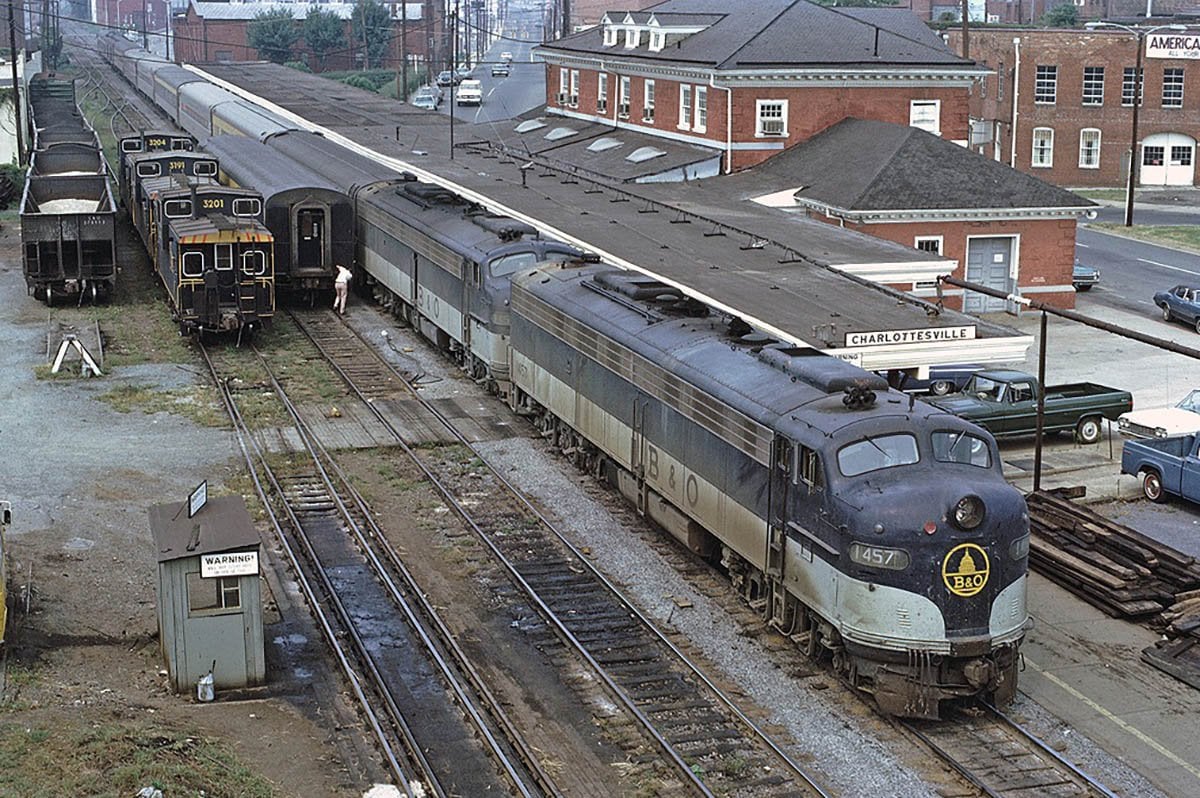
Baltimore & Ohio E9A 1457 leads Amtrak #50, The George Washington, as it stops for passengers at Charlottesville, Virginia, in September 1972. Douglas G. Walker photograph
EMD E8 and E9 Roster
Original Owners
| Model | Railroad | Built | Roadnumber | QTY | Notes |
|---|---|---|---|---|---|
| E8Am | Atchison Topeka & Santa Fe | 1953 | 80L-87L | 8 | Rebuilt as E8s from E1As |
| E8Bm | Atchison Topeka & Santa Fe | 1953 | 80A-82A | 3 | Rebuilt as E8s from E1Bs |
| E8Bm | Atchison Topeka & Santa Fe | 1953 | 83A, 84A | 2 | Rebuilt as E8s from Box Cabs 1, 1A |
| E8A | Atlantic Coast Line | 1950, 1953 | 500, 532, 544-548 | 7 | to Seaboard Coast Line, Amtrak(1) |
| E8A | Baltimore & Ohio | 1950, 1953-54 | 26-32, 26A-32A (even), 51, 53-56, 90, 90A, 92, 92A, 94, 94A, 96, 96A | 21 | to Amtrak(1) |
| E8BM | Baltimore & Ohio | 1953-54 | 51X-56X | 6 | rebuilt from B&O EAs 51-56 |
| E9A | Baltimore & Ohio | 1955 | 34-40 (even) | 4 | to Amtrak(1) |
| E8A | Boston & Maine | 1950 | 3821 | 1 | |
| E8A | Canadian Pacific | 1949 | 1800-1802 | 3 | 1800, 1802 to VIA Rail. 1801 wrecked in 1968. |
| E8A | Central of Georgia | 1950 | 811-812 | 2 | |
| E9A | Chicago & Eastern Illinois | 1958 | 1102 | 1 | to Missouri Pacific 43 |
| E8A | Chesapeake & Ohio | 1951-53 | 4000-4030 | 31 | to Amtrak(1) |
| E8A | Chicago & North Western | 1950-53 | 5019B, 5021A-5031A, 5021B-5030B | 22 | |
| E8A | Chicago, Burlington & Quincy | 1949-50, 1952-53 | 9937B, 9938A-9949A, 9938B-9948B, 9964-9977 | 38 | to Burlington Northern, Amtrak(1) |
| E9A | Chicago, Burlington & Quincy | 1954-56 | 9985A-9989A, 9985B-9989B, 9990-9995 | 16 | to Burlington Northern |
| E8A | Delaware, Lackawanna & Western | 1951 | 810-820 | 11 | to Erie Lackawanna |
| E8A | Electro-Motive Division | 1949 | 952 | 1 | to RI 643 |
| E8A | Erie | 1950-51 | 820-833 | 14 | to Erie Lackawanna |
| E9A | Florida East Coast | 1955 | 1031-1035 | 5 | to Illinois Central 2036-2040 |
| E8A | Fort Worth & Denver | 1952 | 9981A, 9981B | 2 | to Seaboard Coast Line 524, 532, then to Amtrak 230, 231(1) |
| E8A | Gulf, Mobile & Ohio | 1953 | 100A | 1 | |
| E8A | Illinois Central | 1950-1953 | 4018-4033 | 16 | leased to, and some painted for, Amtrak(1) |
| E8B | Illinois Central | 1952 | 4104-4105 | 2 | |
| E9A | Illinois Central | 1954, 1956-57, 1961 | 4034-4043 | 10 | |
| E9B | Illinois Central | 1956-57 | 4106-4109 | 4 | |
| E8A | Kansas City Southern | 1952 | 23, 26-29 | 5 | |
| E9A | Kansas City Southern | 1959 | 25 | 1 | to C&NW 5032A |
| E8A | Louisville & Nashville | 1951 | 794-797 | 4 | to Amtrak(1) |
| E9A | Milwaukee Road | 1956, 1961 | 36A-38A, 36C-38C, 200A-205A, 200C-200C | 18 | to Amtrak(1) |
| E9B | Milwaukee Road | 1956 | 200B-205B | 6 | to Amtrak(1) |
| E8A | Missouri Pacific | 1950 | 7018-7021 | 4 | to MP 38-41 |
| E8A | Missouri-Kansas-Texas | 1950-51 | 106A-107A, 106C-107C, 131-135 | 9 | to 52A. 53A, 52C, 53C, 54A, 54C, 55A, 55C, 56A |
| E8A | Missouri-Kansas-Texas | 1950-51 | 52A. 52C, 53C, 54A, 55A, 55C, 56A | 7 | to Atlantic Coast Line (via Precision National Corp.), Seaboard Coast Line, Amtrak(1). 55A's disposition is unknown |
| E8A | Missouri-Kansas-Texas | 1950-51 | 53A, 54C | 2 | rebuilt by EMD into E9A (1957); to Atlantic Coast Line (via Precision National Corp.), then to Seaboard Coast Line, Amtrak |
| E8A | New York Central | 1951-53 | 4003, 4020, 4036-4095 | 62 | to Penn Central, Amtrak(1) |
| E8A | Pennsylvania | 1951 | 5808A-5810A, 5835A-5839A, 5894A-5899A, 5902A-5905A | 18 | to Penn Central, some to Amtrak(1) |
| E8A | Pennsylvania | 1950 | 5884A-5893A | 10 | to Penn Central, some to Amtrak(1) |
| E8A | Richmond, Fredericksburg & Potomac | 1949, 1952-53 | 1001-1015 | 15 | to Amtrak(1) |
| E8B | Richmond, Fredericksburg & Potomac | 1949 | 1051-1055 | 5 | |
| E8A | Chicago, Rock Island & Pacific | 1949 | 643 | 1 | ex-EMD 952 |
| E8A | Chicago, Rock Island & Pacific | 1949-50, 1952-53 | 644-655 | 12 | |
| E8A | Chicago, Rock Island & Pacific | rebuilt 1953 | 656 | 1 | rebuilt from RI E6A 627 |
| E8A | Chicago, Rock Island & Pacific | acq 1969 | 657-661 | 5 | ex-UP 625, 930, 935, 937, 941 |
| E8B | Chicago, Rock Island & Pacific | acq 1969 | 613-620 | 8 | ex-UP 930B, 931B, 936B, 937B, 938B, 939B, 946B, 947B |
| E9A | Chicago, Rock Island & Pacific | acq 1969 | 622-625 | 4 | ex-UP 900, 901, 903, 905 |
| E8A | Seaboard Air Line | 1950, 1952 | 3049-3059 | 11 | to Seaboard Coast Line, Amtrak(1) |
| E9A | Seaboard Air Line | 1963 | 3060 | 1 | to SCL 599, AMTK 404 |
| E8A | Southern Pacific | 1950 | 6018 | 1 | |
| E9A | Southern Pacific | 1954 | 6046-6054 | 9 | |
| E8A | Southern Railway | 1951 | 2923-2929 | 7 | to Southern Railway 6900-6905, 6916 |
| E8A | Southern Railway (New Orleans & Northeastern) | 1953 | 6906-1615 | 10 | to Southern Railway 6906-6915 |
| E8A | St. Louis-San Francisco | 1950 | 2006-2022 | 22 | |
| E8A | Texas & Pacific | 1951 | 2010-2013 | 4 | to Missouri Pacific (T&P) 30-33 |
| E8A | Union Pacific | 1950, 1953 | 926-942 | 17 | to various roads (AMTK, CNW, RI) |
| E8B | Union Pacific | 1950, 1953 | 922B-949B | 28 | |
| E9A | Union Pacific | 1954-56, 1961-64 | 900-914, 943-962 | 35 | to Amtrak(1) |
| E9B | Union Pacific | 1954-56, 1962-64 | 900B-904B, 910B-913B, 950B-974B | 34 | to Amtrak(1) |
| E8A | Wabash | 1949, 1951, 1953 | 1000, 1003-1015 | 14 | to Norfolk & Western 3800-3815 |
| Not all dispositions shown … It gets complicated … and you can look it up online. Sorry. | |||||
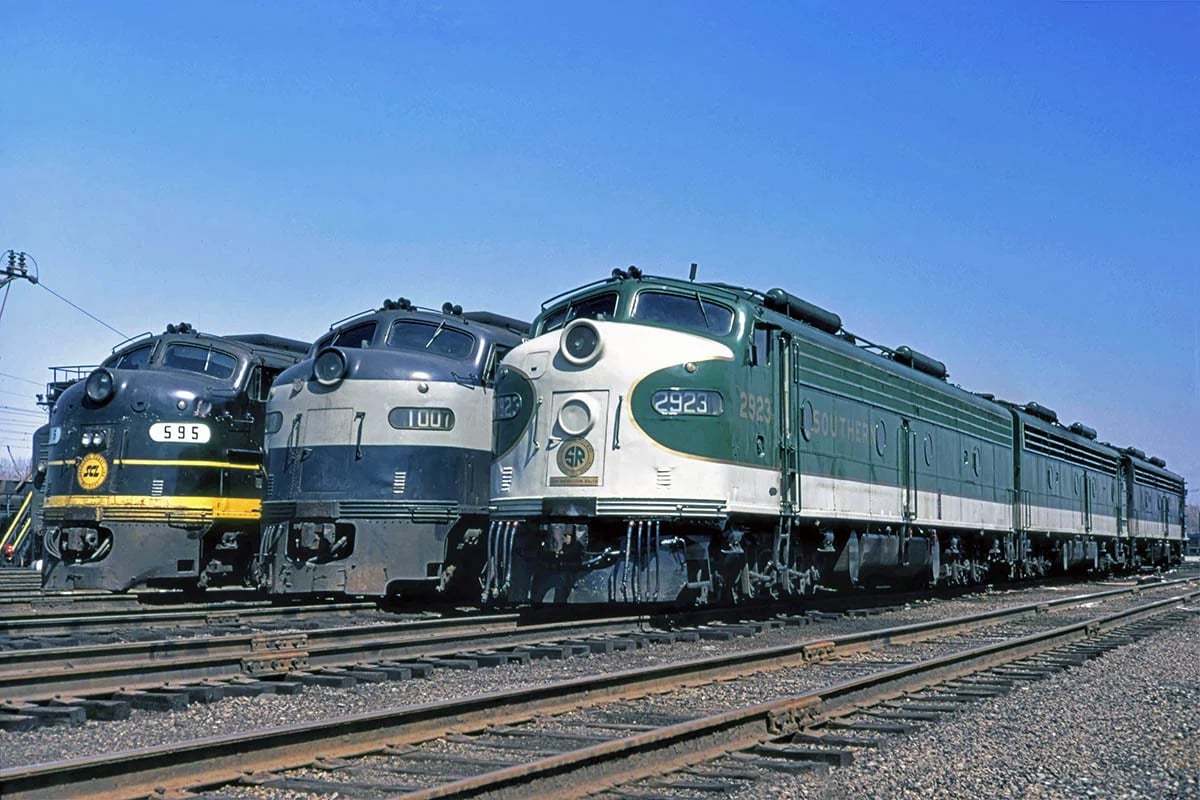
E8As from three railroads gathered in Amtrak’s Ivy City facility in Washington DC on April 6, 1972. In the foreground are some Southern Railway Es, and the modification to the air reservoirs is clearly visible on these engines’ roofs. Next to them are some Richmond Fredericksburg & Potomac E8s, with 1007 on the head-end, which would become Amtrak 216 and, later, AMTK 439. On the next track over are E8s belonging to Seaboard Coast Line. SCL 595 is the former Seaboard Air Line 3056, which would later become Amtrak 252. Photographer unknown, Robert Graham collection
Later in Life – Head-End Power
Pretty much since the beginning of railroading, heat for passenger cars was supplied by steam piped through the cars from the steam locomotive, and later the steam-generators installed in passenger diesels. Electricity for lighting, ventilation/air conditioning and other needs was produced through generators on each car, which were connected to the axles, the rotation of which powered the generators. The flaw with these systems showed up with the widespread advent of commuter trains, which often made so many stops that the generators were unable to keep up with the train’s electrical needs. One of the first to notice this inadequacy, even in the steam-era, was the Boston & Maine, which operated a number of commuter trains. The railroad installed higher capacity generators on the locomotives assigned to these trains, with electrical cables carrying the power throughout the train.
Initially, Head-End Power (HEP) was primarily found on commuter trains, with railroads such as Chicago & North Western (and others) replacing the older technology with HEP by installing diesel generator sets that operated at a constant speed, most noticeable when a train was stopped at a station and the locomotive sounded as it if were still running at high speed, and generating AC power to the cars. Other commuter operators follow suit, with Burlington Northern upgrading their cars and E-units as well.
As the slump in passenger loadings on intercity passenger trains caused the railroads to put improvements on hold. Even the first new power for Amtrak, the EMD SDP40F, constructed from June 1973 to August 1974, were equipped with steam generators. By 1975 Amtrak began receiving new Amfleet cars and new EMD F40PH and GE P30CH locomotives with HEP. Much Amtrak’s fleet of older passenger cars, inherited from those railroads operating before the advent of Amtrak, were rebuilt to HEP as well as the SDP40Fs fell out of favor and more F40PHs were built. Five Amtrak E-units were rebuilt with HEP to handle some trains.
On these rebuilt E-units, the most obvious external difference was the replacement of the steam generator exhaust vents on the roof’s rear with HEP exhausts, which were generally boxier. Each road’s conversions were unique, so the roof of an Amtrak E-unit differed from a Chicago Burlington & Quincy E-unit, which wasn’t the same as a later Burlington Northern E-unit, which was not the same as Chicago & North Western’s E-units, ad infinitum. CB&Q added a large louvered area toward the rear of the sides, where the steam generators used to be located, and those Es rebuilt by BN had a horizontal panel covered in louvers in the same general location, forcing the white roadnumber from its usual location under the wide white stripe onto the white stripe, and requiring the number to be Cascade Green instead. (Many of the BN units ended up being sold to other carriers, such as Chicago’s RTA and Metra, plus MARC in Maryland, Illinois Central, Canadian National and Iowa Pacific. C&NW’s units had an opening in the grille area, making the usual grilles shorter as a result. Amtrak had no new side vents.
Which brings to mind the standard railroad modeling admonition: Check photos! (Along with, “Google is your friend!”)
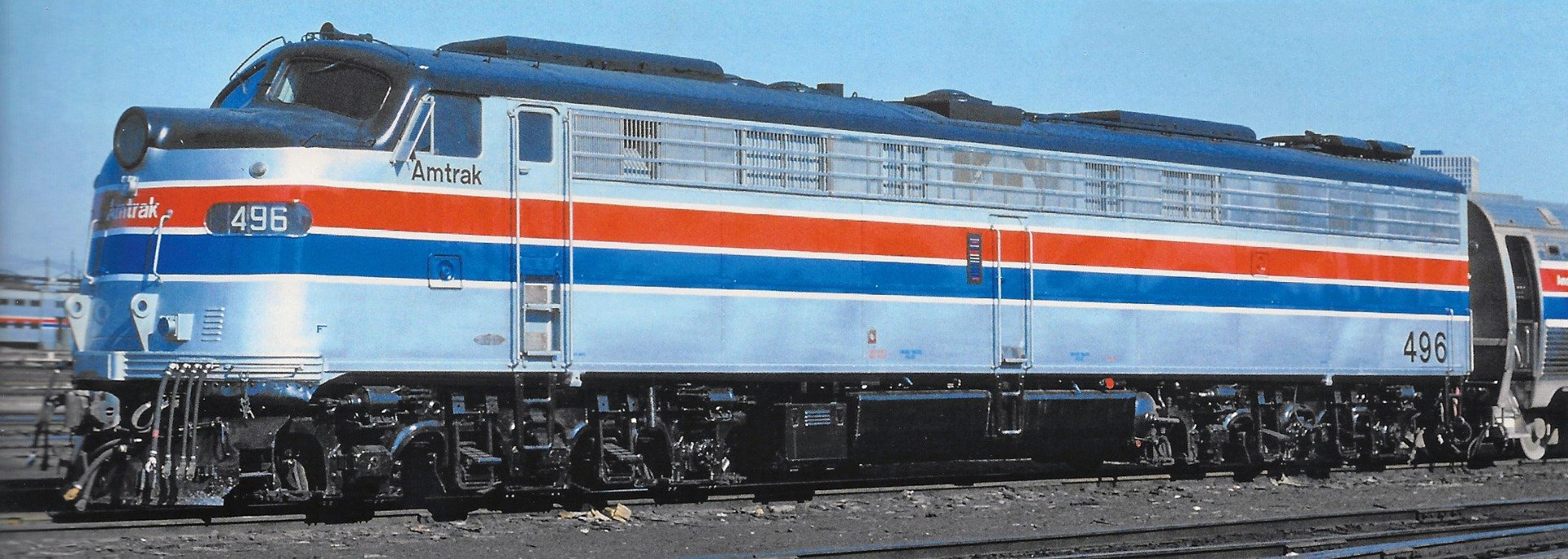
One of Amtrak’s HEP equipped E8As, 496, was photographed in Chicago IL on April 10, 1976. Note the HEP equipment on the rear of the roof. (The dynamic brake fan the center of the roof was rebuilt as well, but that may not be as a result of the HEP.) Amtrak called these five HEP equipped locomotives (495-499) “E8HEP” diesels. AMTK 496 was built as Pennsylvania Railroad E8A 5710A, which later became Penn Central 4280 and, in 1971, AMTK 288, and it was converted to HEP at Penn Central’s Altoona (PA) shops in August 1974. Joe McMillan photograph
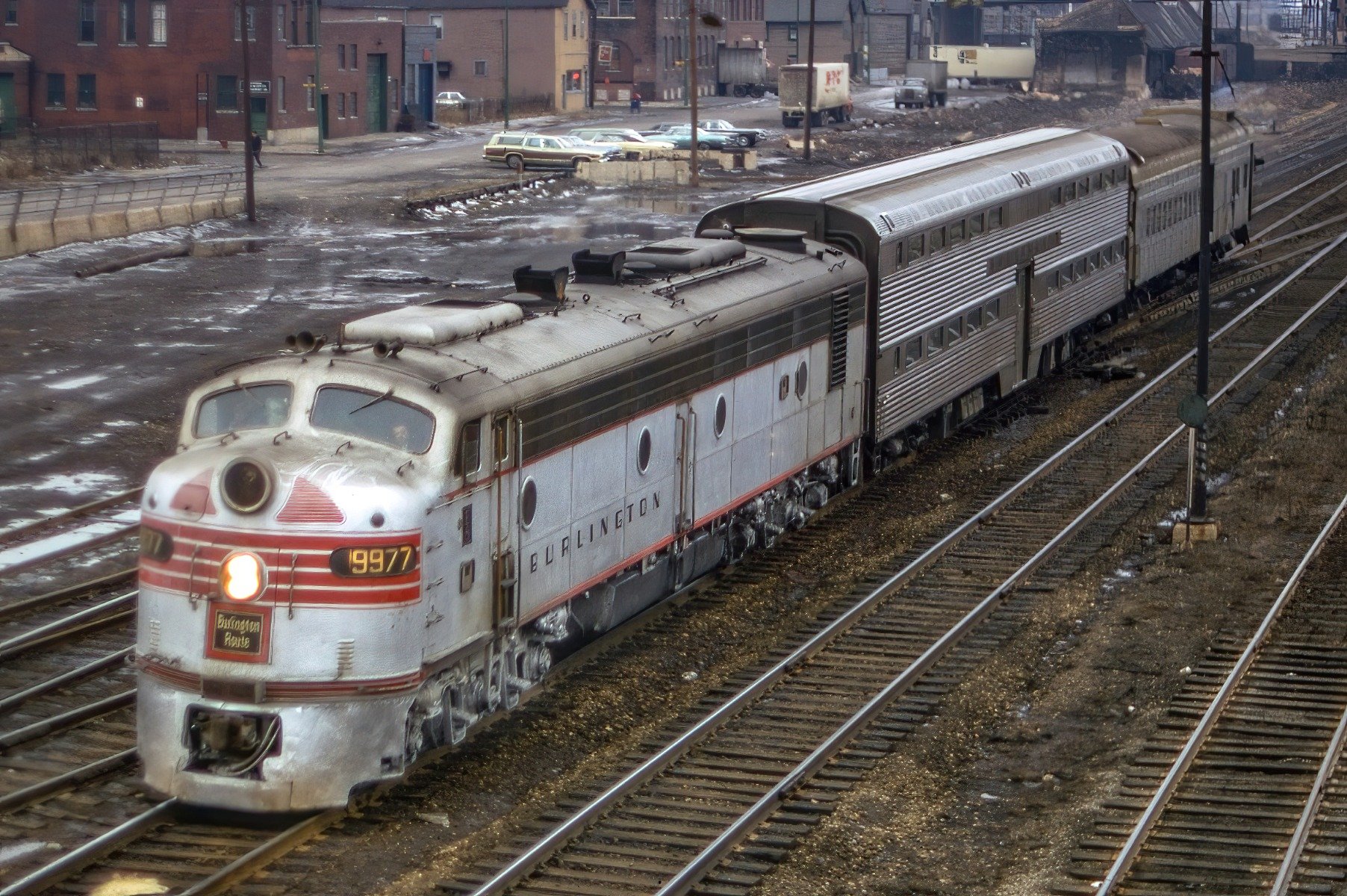
Chicago Burlington & Quincy converted their E8As and E9As to HEP. Here, in March 1970, is E8A 9977 in Chicago IL with what appears to be a track evaluation train. Note the large circular HEP vent on the roof, as well as the new vertical grille added to the side underneath it. Later this year, CBQ 9977 would become Burlington Northern 9967, and later BN 9904 … and, eventually, Illinois Central 101, operated on that road’s business car trains. Rich Panek photograph, Gregory J. Sommers collection
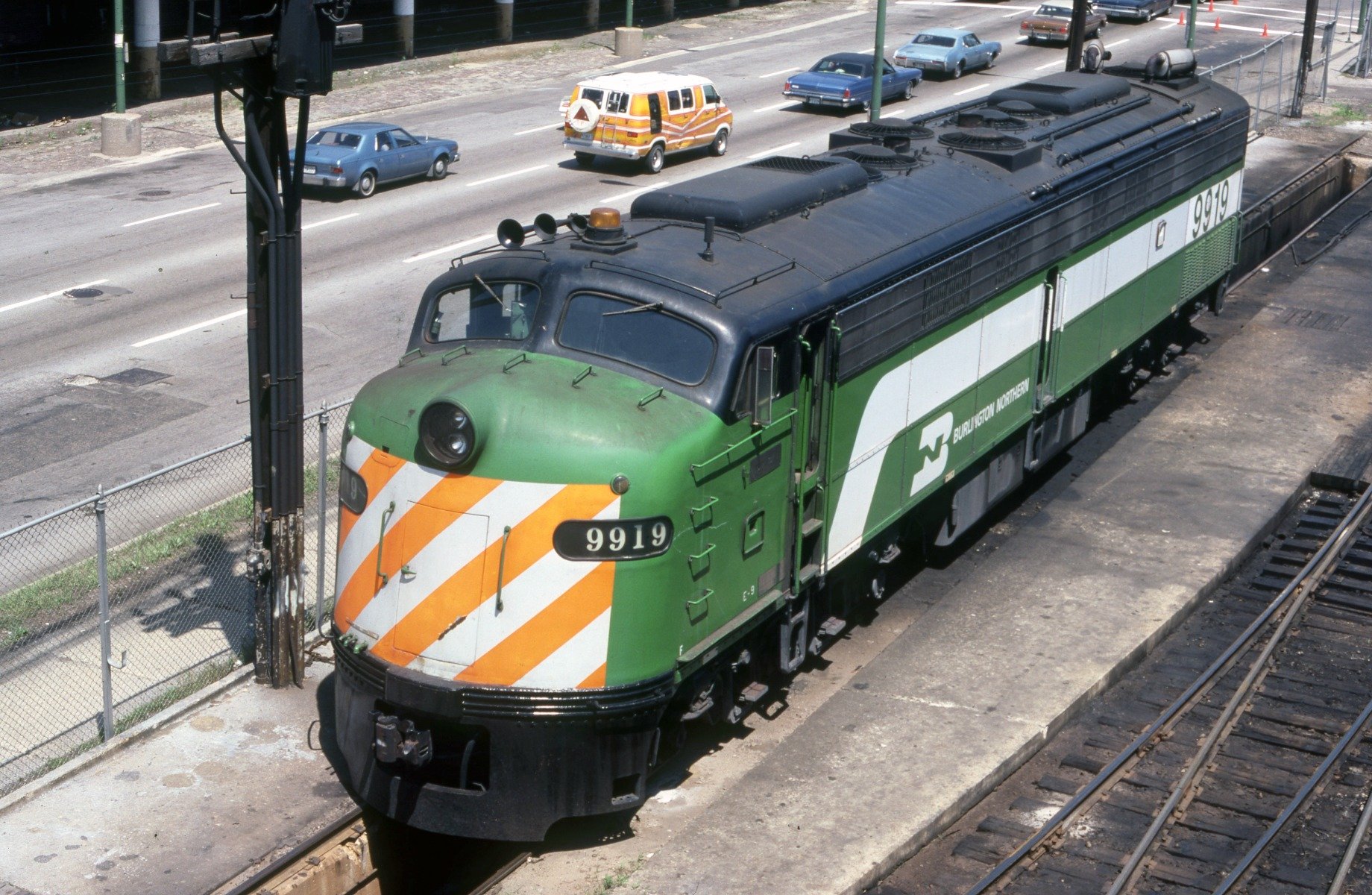
Burlington Northern E9A 9919 (ex-BN 9989, né-CBQ 9989A) shows the later HEP installation on BN’s commuter E-units. First of all, and unrelated to the HEP, the fuel tank has been modified, and dynamic brakes were added to the center of the roof in the way of side-by-side 36” fans. As for the HEP on the rear of the roof, there is a 48” fan and a pair of mufflers, and some new piping up there too. On the diesel’s sides, at the rear under the white stripe, is a panel with numerous louvers (which forced the railroad to put the normally white road number higher, in the white stripe, and also in Cascade Green). At this time, too, the diagonal white nose stripes had high-visibility fluorescent oranges stripes added as well. BN 9919 would eventually become BN 3, assigned to the railroad’s business trains and repainted into the Grinstein Green and Tan scheme found on the BN’s SD70MACs. . George Cockle photograph, Gregory J. Sommers collection
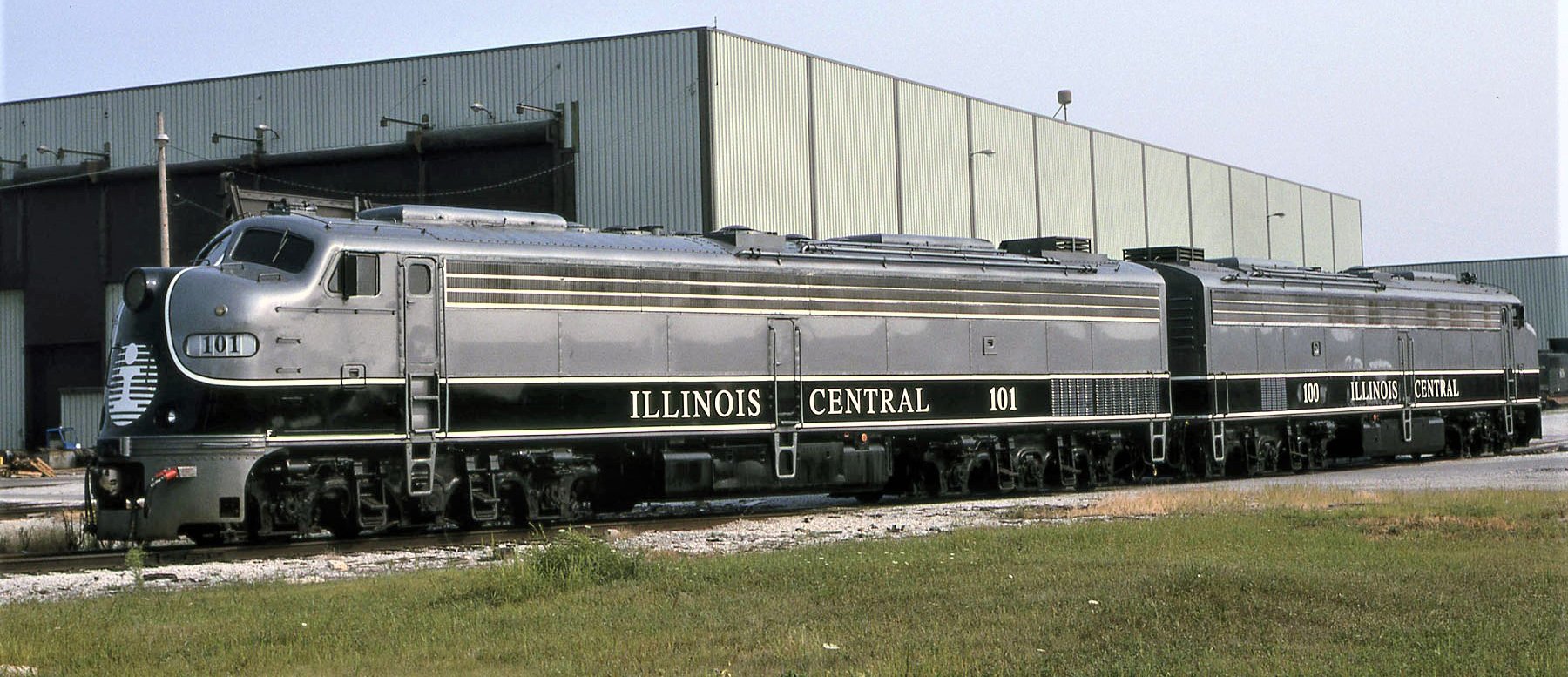
A pair of Illinois Central’s executive E8As, 101 and 100, sit outside the railroad’s shops in East Hazel Crest IL. IC 101 is the former BN 9904, BN 9967, originally CBQ 9977. IC 100 is ex-BN 9901, ex-BN 9938, née-CBQ 9938A. The diesels have the later BN-style HEP features (naturally), but there is some additional structure on the roofs to protect the vents. And ditch lights have been added to their noses. Bob Graham photograph
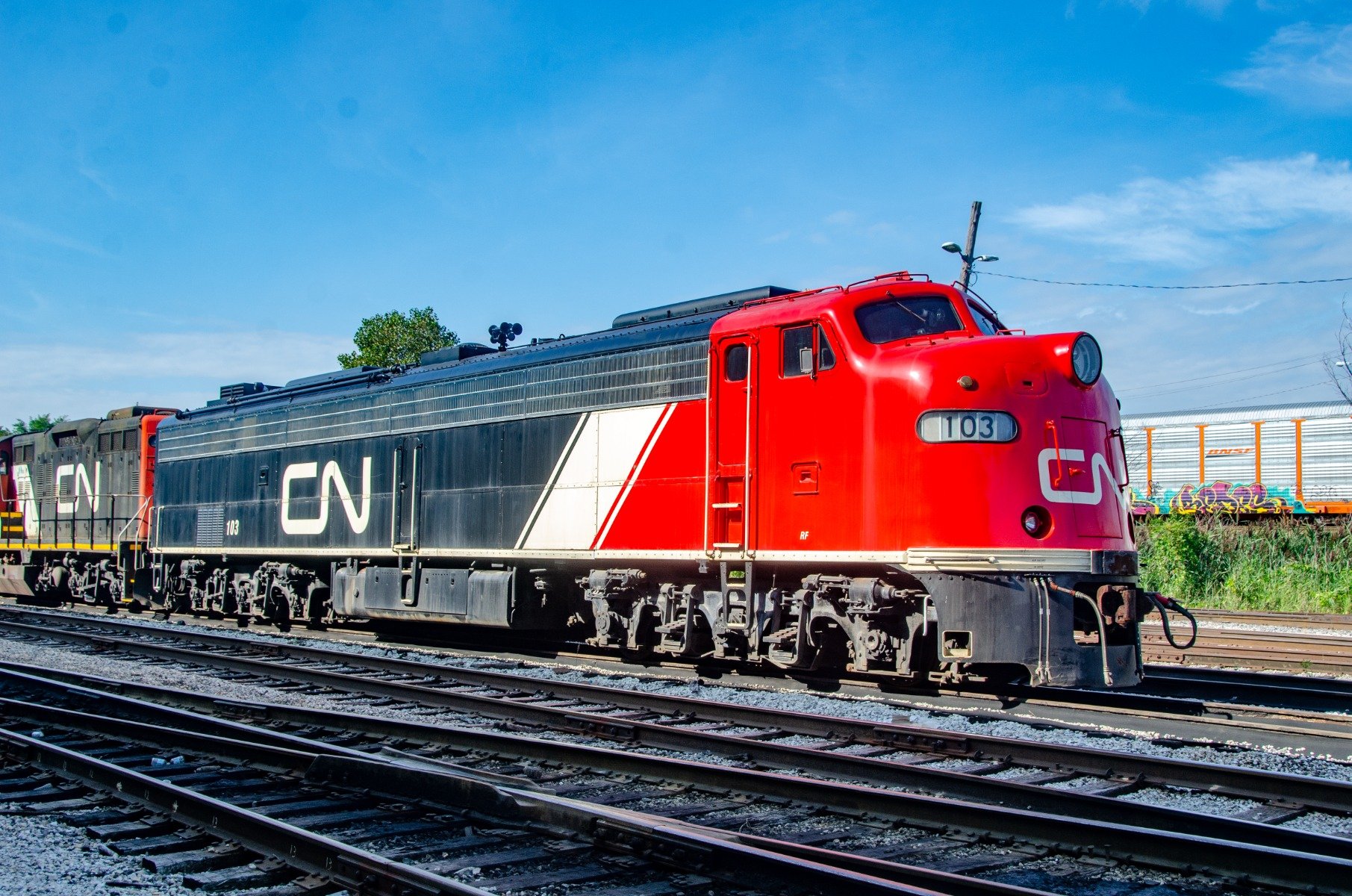
With the acquisition of the Illinois Central by Canadian National in 1999, their E-units became Canadian National property, and sitting behind the CN’s Woodcrest Locomotive Shops (in Homewood IL) on the last day of September 2018 is E9A 103. The lineage of this diesel is ex-IC 103, ex-BN 9916, ex-BN 9986, née-CBQ 9986A. This photo provides a good view of the modified fuel tank, and the rooftop HEP vents appear to have been modified yet again, too. Craig Walker photograph
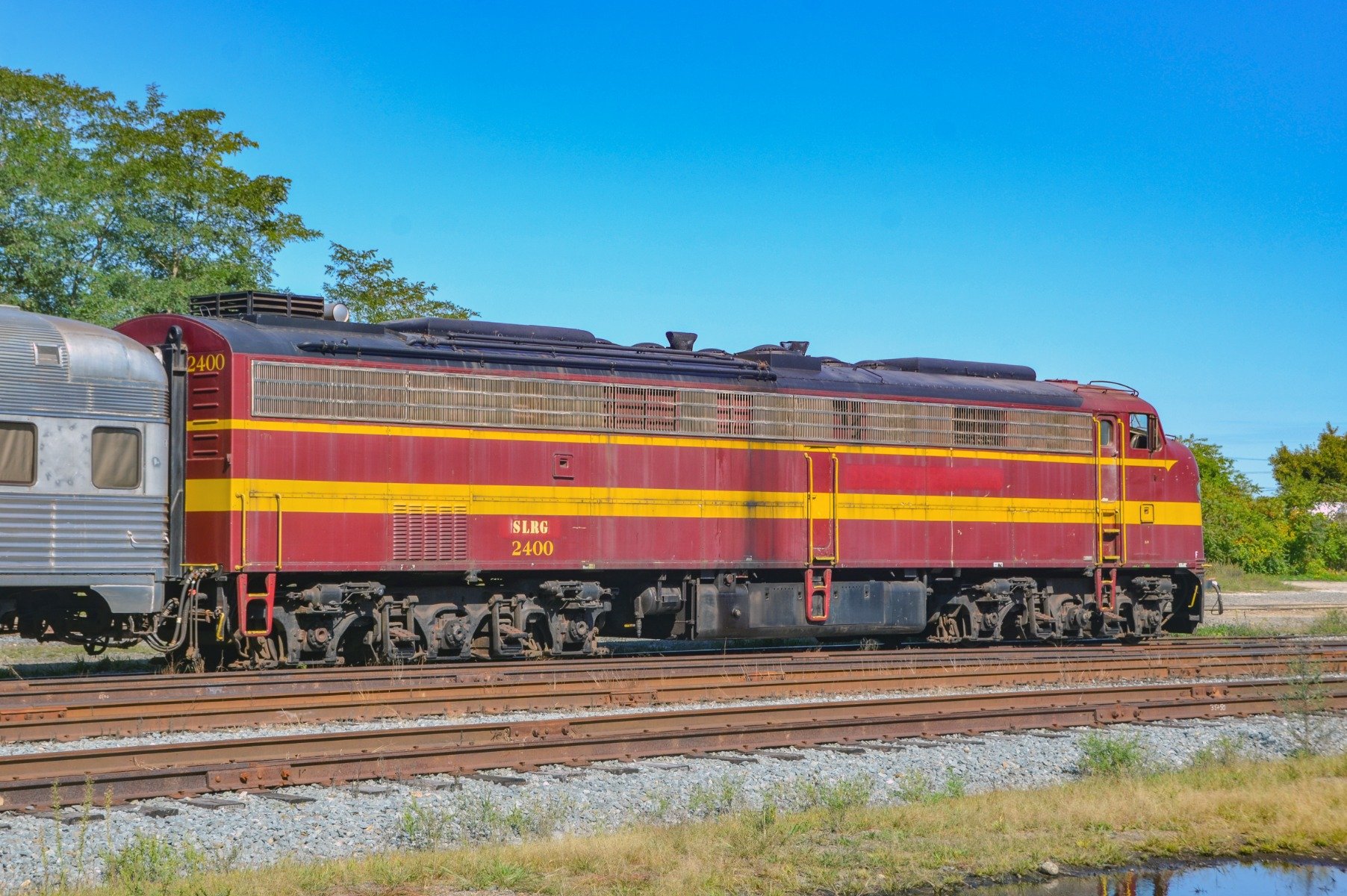
A good view of the Burlington Northern HEP installation can be seen on San Luis & Rio Grande E9A 2400 (ex-NYSW 2400, ex-BN 9921, née-CBQ 9991A), yet to be relettered by its new owner, the Massachusetts Coastal Railroad, on this September 22, 2016, day. While much of the detail of the HEP vents is hidden by the louvered box on its roof, we can see the muffler and, very nicely, the piping added to the roof. This also shows well the louvered panel on the locomotive’s right side, which is shorter than that found in its left side. Note, too, the flat panels on the lower portion of the rear end. Craig Walker photograph
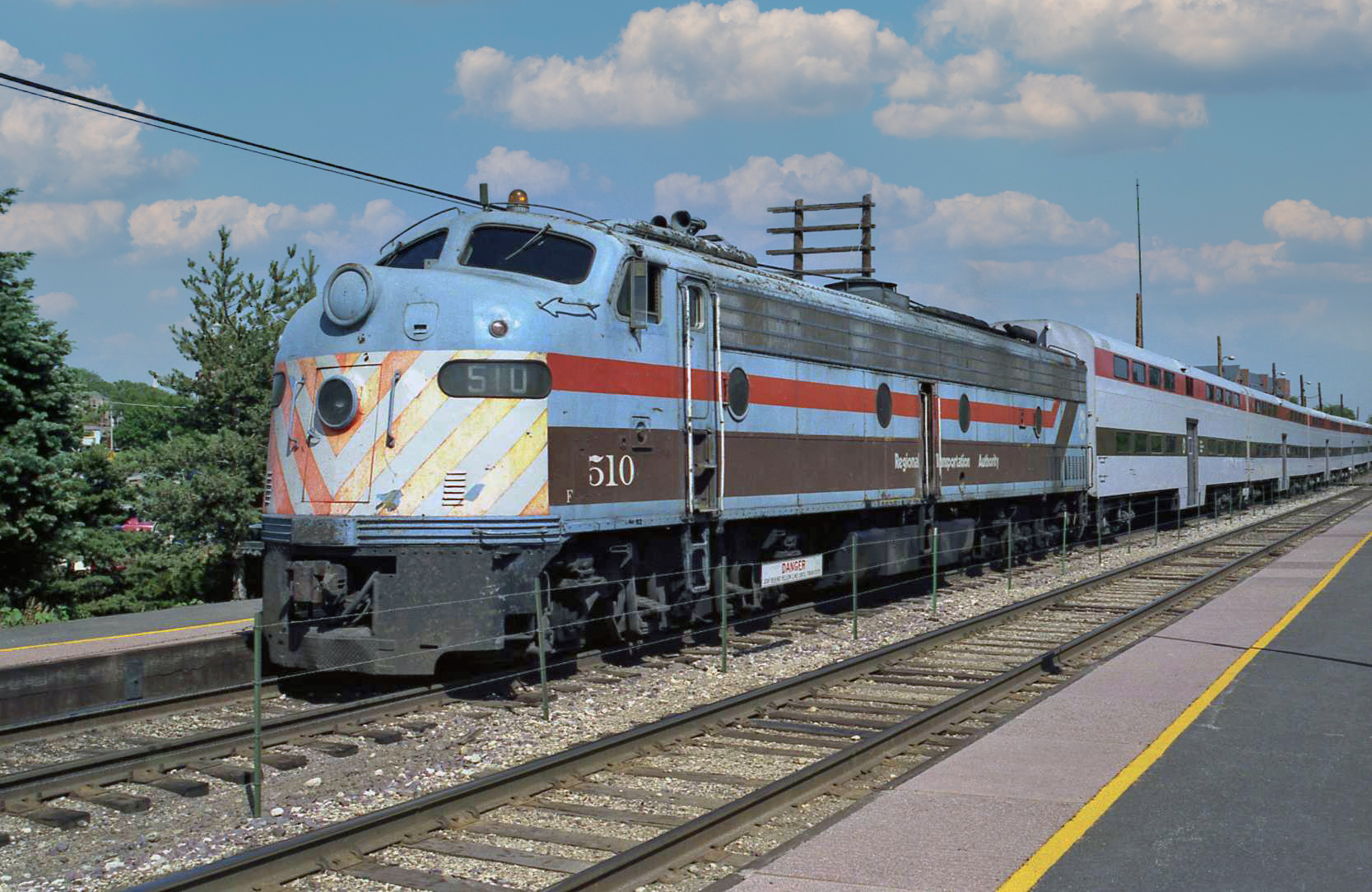
Chicagoland’s Regional Transportation Authority inherited a number of Chicago & North Western’s commuter E-units. Pulling a train through Park Ridge IL on June 23, 1988, is Metra E8A 510 (ex-CNW 510, née-UP 942). Converted to HEP by the CNW after it was acquired from Union Pacific, this locomotive also had its dynamic brakes fans modified (to side-by-side 36” fans). The HEP installation is similar, but not identical, to those installed on the BN’s Es. (This locomotive later found its way to the Southern California Railroad Museum [Perris CA], where it was restored to UP markings.) Dale Martin photograph
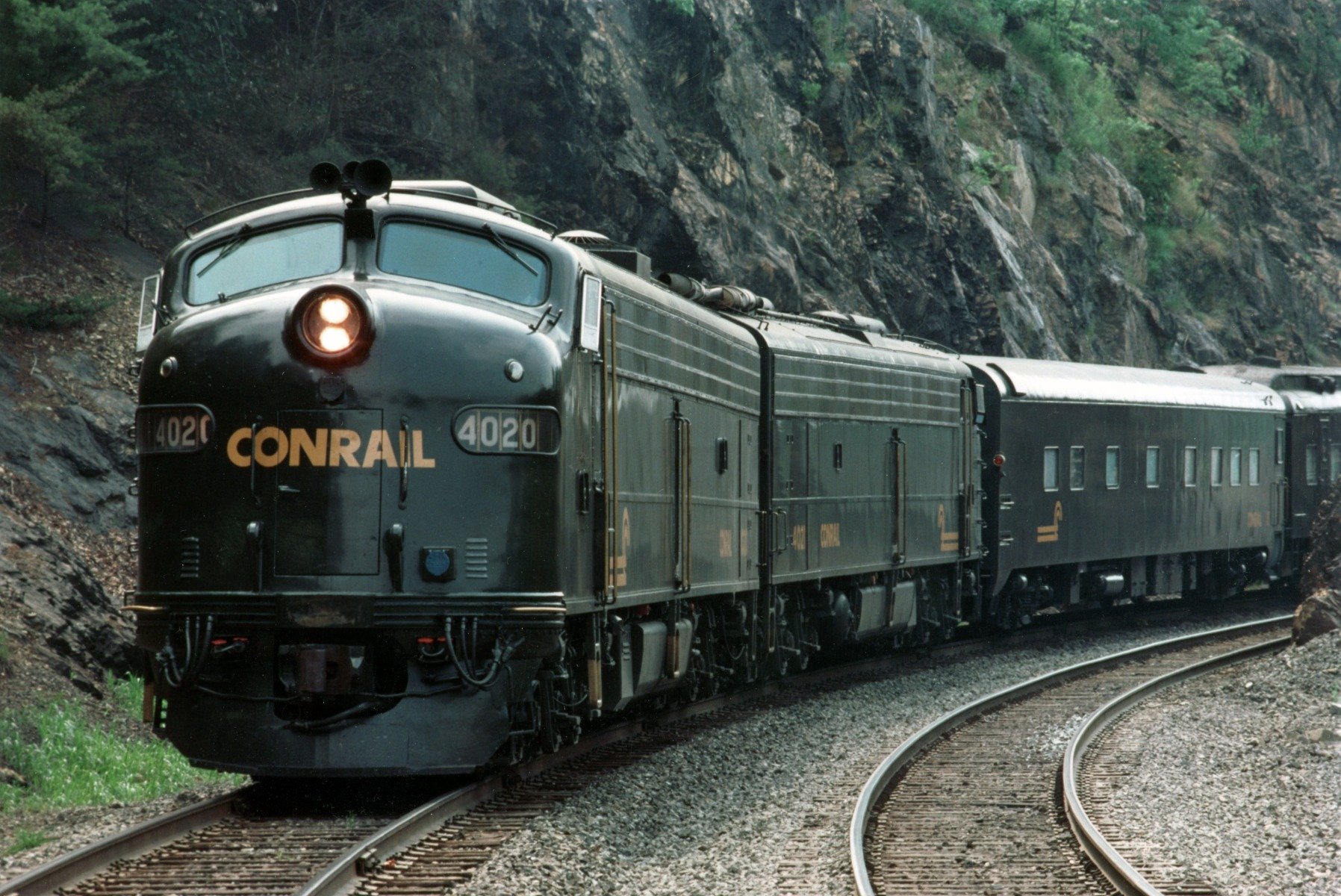
Conrail’s two E8As, 4020 and 4021, lead an inspection train in Pennsylvania. CR 4020 is ex-AMTK 498, ex-AMTK 315, ex-PC 4309, née-PRR 5809A, and CR 4021’s heritage is ex-AMTK 499, ex-AMTK 317, ex-PC 4311, née-PRR 5711A. The diesels were painted dark green (the Pennsy’s iconic “Dark Green Locomotive Enamel”). Conrail photograph, Dale Martin collection
Acknowledgements
Thanks to Bob Graham, Thomas Greenman, John Hawkins, Ron Hawkins, Dale Martin, Joe McMillan, Leo J. Munson, Greg Sommers, Douglas G. Walker and Craig Willett for their assistance!
